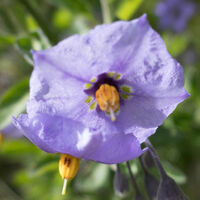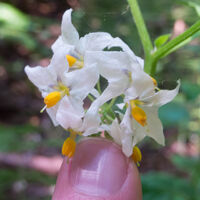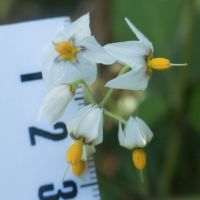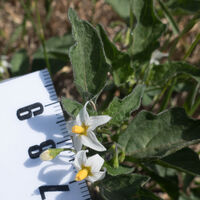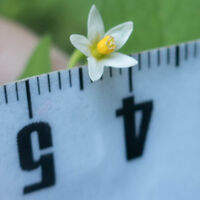nightshades
genus Solanum
Member of
nightshade family (family Solanaceae)
dicots (class Magnoliopsida)
flowering plants (subphylum Angiospermae)
Except for old historical records and extremely rare examples that I don't expect to encounter, there are no other wild species of this genus in the bay area.
The anthers are generally fused to form a golden longitudinally-segmented tube from which the style may or may not be exserted.
The european “deadly nightshade” can be fatal after eating as few as 10 berries, but it is a different genus with a different toxin. Ripe nightshades (genus Solanum) berries are non-toxic, but the leaves and unripe (green) berries are quite toxic, although probably not fatal. [source] However, I wouldn’t eat any of it if I were you.
Purple-flowered nightshades
Key features:
- Hairs are branched or 0/simple on upper stem (not flower pedicel). The hairs are so tiny that maximum camera close-up doesn’t always show them branching, but it does show them matted rather than straight.
- Leaf shape. There is some overlap, but the shapes are often distinct.
new zealand nightshade
Solanum aviculare
- leaf 10–30 cm, ± entire to deeply 1–2-lobed below middle
- no iNaturalist observations in the bay area
- rare in Calflora, mostly in urban areas
silverleaf nightshade
Solanum elaeagnifolium
- plant often prickly
- [leaves look different than bluewitch nightshade (Solanum umbelliferum)
- yellow fruit
- very rare in the bay area, mostly associated with mulch in urban areas
White-flowered nightshades
Fruit key features:
Flower key features:
- corolla diameter
- style strongly exserted or not
- filaments (the portion visible below the anther) distinct or not
- anther length
Stanford’s Jasper Ridge program has a key (PDF) for some white-flowered nightshades. Much more information about useful and non-useful features are in a free research article by Knapp et al.
The inflorescence typically has its flowers branching from a very short rhachis (axis), although occasionally they can be spaced out more. Jepson and Stanford pretend to distinguish raceme-like and umbel-like inflorescences, but there appears to be no consistent difference. The inflorescence is usually distinctly forked in {-forked nightshade), but other species may also rarely be forked.
Jepson and Stanford both list deceptive corolla widths which I have corrected according to my observations and Knapp. I’ve copied the anther lengths from Jepson, but have not yet attempted to verify their ranges.
The anthers are closely packed to form a golden longitudinally-segmented tube from which the style may or may not be exserted.
Style strongly exerted
Solanum furcatum
- inflorescence forked into two distinct, ± balanced sections
- corolla: 12–20 mm diameter including lobes, white w/ yellow/green spots at base
Solanum douglasii
- infloresecnce rarely forked
- peduncle 1.5–4 cm long; pedicels 10–41 mm long, 0.3–0.4 mm in diameter at the base and 0.4–0.6 mm in diameter at the apex
- corolla: 13–15+ mm diameter including lobes, white, possibly tinged with lavender, w/ yellow/green spots at base often with a brown tinge or margin
- anthers 2.5–4.5 mm
- filaments indistinct; free portion (below the anthers where the filaments are not fused into a single tube) (0.1–0.5 mm) about ¼ the length of the anther (3–4.5 mm, usually > 4 mm in North America)
- style strongly exerted beyond anthers
- bud ± ellipsoid, tapering to the apex
- leaf: 1–9 cm, entire to coarsely irregularly toothed
- hairs: generally simple, < 1mm, ± curved, white
- fruit: glossy w/ sepals not reflexed
- stems angled, rough-hairy, woody
Style weakly exerted at most
Solanum nigrum
- infloresecnce rarely forked
- peduncle 0.5–1.5 cm long, straight; pedicels 3–5 mm long, 0.2–0.3 mm in diameter at the base and 0.2–0.3 mm at the apex
- corolla: 10–17 mm diameter including lobes, white w/ yellow/green spots at base
- leaf: 4–7 cm, entire to coarsely wavy-toothed
- hairs: ± spreading or curved, glandular and not
- calyx lobes partially fused, not reflexed in fruit
- fruit: dull
Solanum americanum
- corolla: 5–8 mm diameter including lobes [example], white
- anthers 1.4–2.2 mm
- style not strongly exerted beyond anthers
- note that the style-to-anther ratio listed in Jepson is similar in all white nightshades, but this one has longer filaments
- infloresence typically umbel-like, but rarely highly branched
- leaf: 2–15 cm, entire to coarsely wavy-toothed
- hairs: ± 0 or short, ± appressed or curved, nonglandular
- fruit: glossy w/ sepals reflexed
Toxicity of deadly nightshade (Solanum spp.):
4 – Ingestion of these plants, especially in large amounts, is expected to cause serious effects to the heart, liver, kidneys or brain. If ingested in any amount, call the poison center immediately.
5 observed taxons / 4 unobserved taxons / 1 key
Locations: Months: For more details, use advanced search.
Chris’s observations: 171 (145 are research grade)
Taxon info: iNaturalist – Calflora – Jepson eFlora – FNA
Bay Area species: iNaturalist – Calflora
